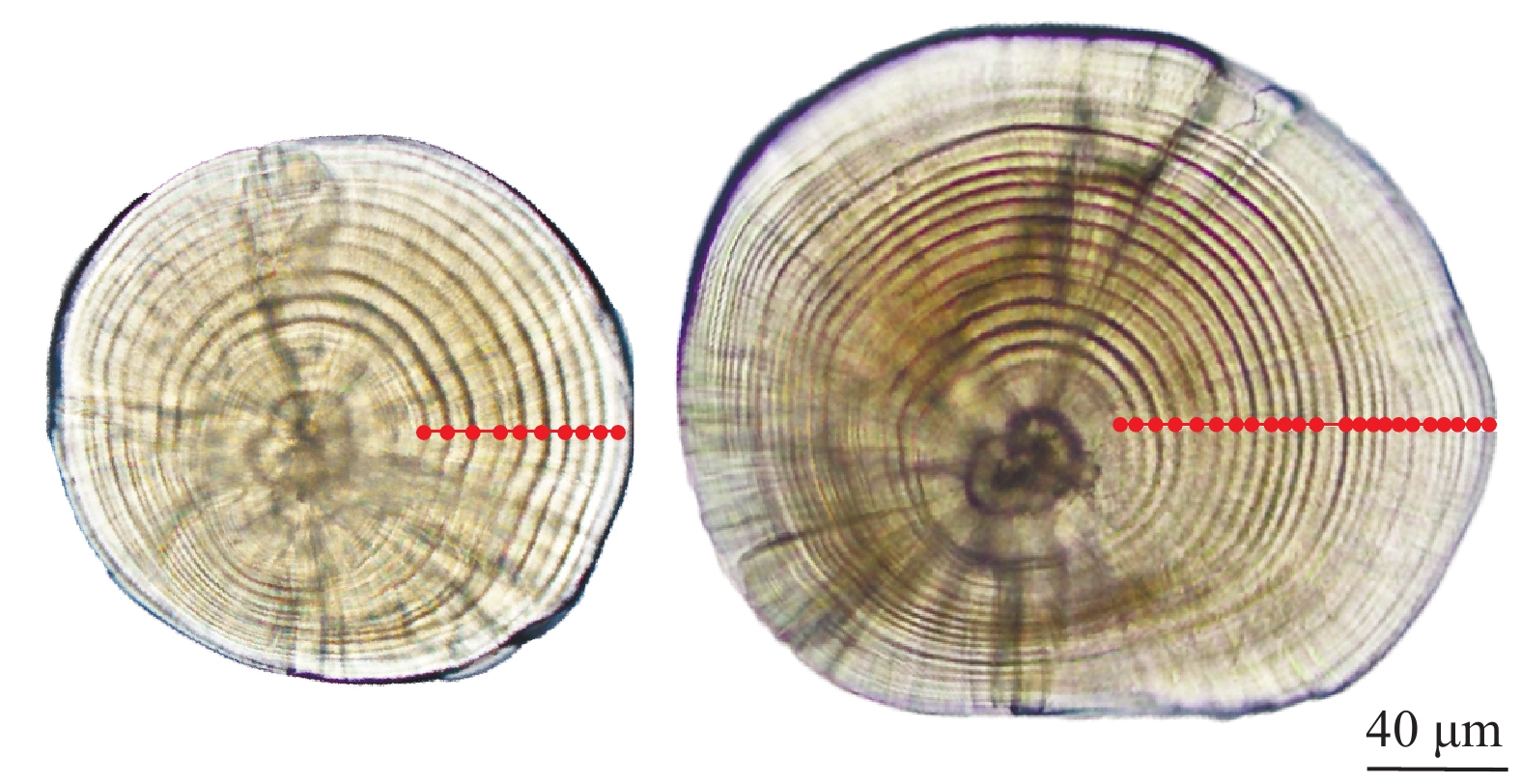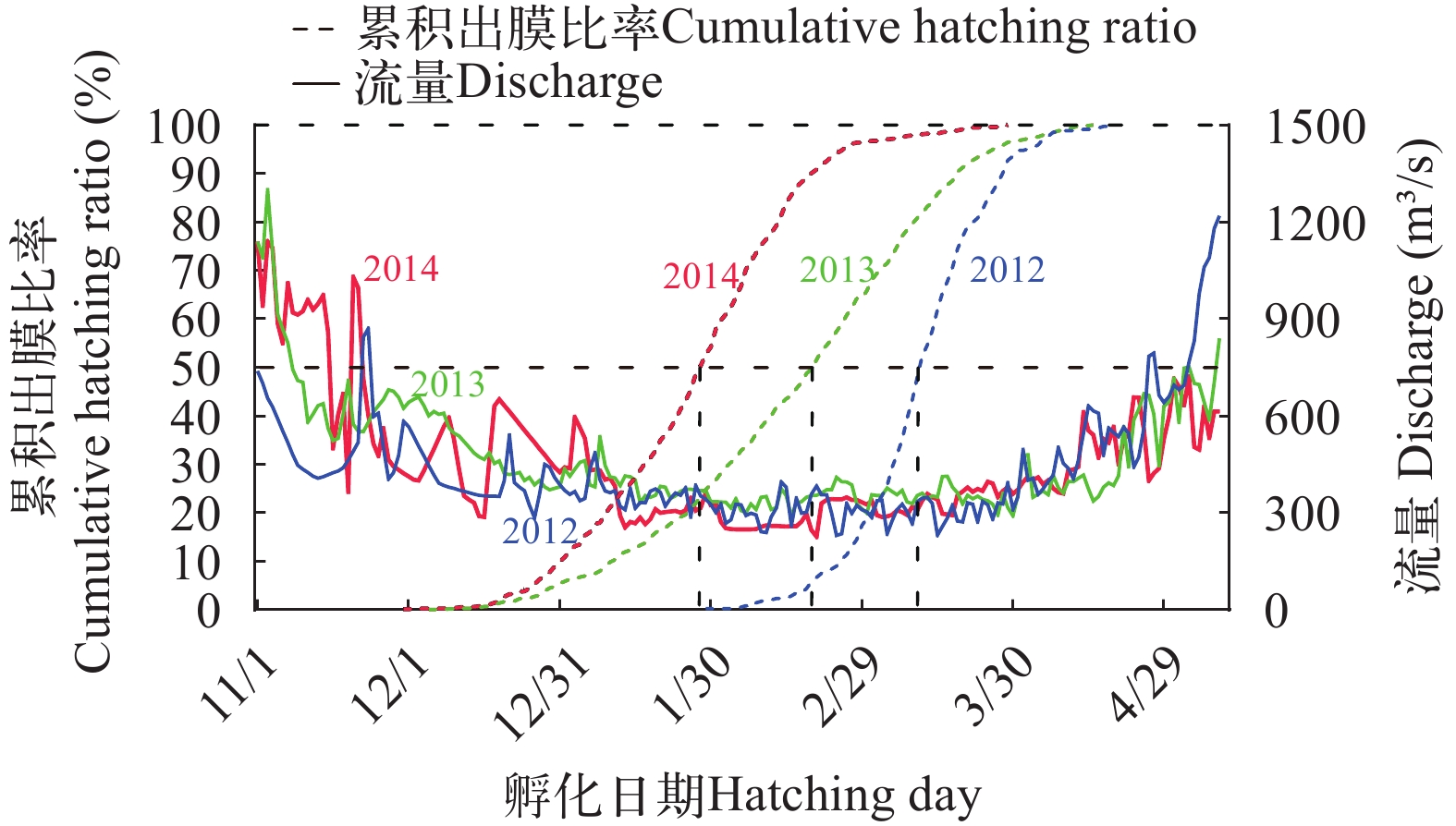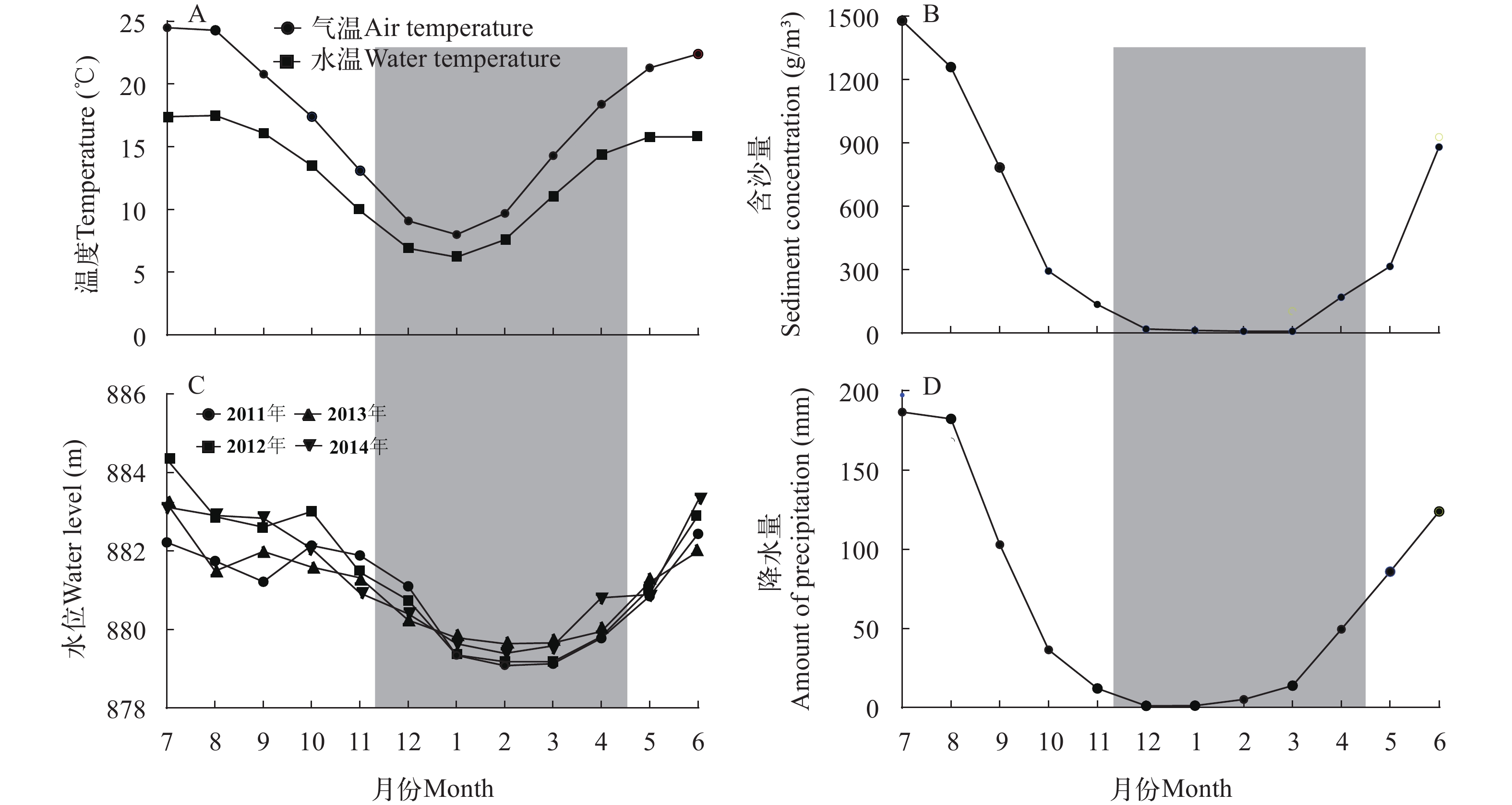REPRODUCTION TIME AND MAIN INFLUENCING FACTORS OF SCHIZOTHORAX PRENANTI IN THE MIDDLE REACHES OF THE DADU RIVER
-
摘要:
为了解天然条件下齐口裂腹鱼(Schizothorax prenanti)的繁殖规律, 文章采用耳石日轮技术对2012—2014年采自大渡河中游的齐口裂腹鱼仔稚鱼样本进行了出膜期推算, 并在此基础上结合胚胎发育积温和水文因子等分析了亲鱼产卵时间及其影响因素。结果表明: 在人工养殖条件下的齐口裂腹鱼胚胎发育积温是1467.36℃·h。采集的仔稚鱼出膜时间为11月30日至次年的4月19日, 并由此推算出其亲本产卵时间为11月8日至次年的4月11日, 繁殖高峰期为1月上旬至3月中旬。相关性分析发现, 亲鱼的繁殖活动与流量、水温、气温、降水量、含沙量和水位呈显著负相关(P<0.05), 亲鱼产卵时间和仔鱼出膜时间主要集中于流量小、水温低、水位小、降水少和含沙量小的11月至次年4月的枯水期时段。频繁或集中的流量波动, 能更好地刺激齐口裂腹鱼进行产卵活动。研究结果为齐口裂腹鱼野生种群繁殖规律研究及其资源保护措施制定等提供基础数据。
Abstract:In order to understand the natural spawning pattern of Schizothorax prenanti, we calculated the hatching period of S. prenanti larvae and juveniles collected from the middle reaches of the Dadu River from 2012 to 2014. The spawning period of the parent fish was determined by integrating the accumulated temperature required for fertilized egg development. Additionally, we conducted an analysis of the correlation between hydrological factors and their spawning activity. The results showed that the incubation accumulated temperature for fertilized eggs of S. prenanti under artificial breeding conditions was 1467.36℃·h. The hatching time for collected juvenile fish spanned from November 30th to April 19th of the following year, and the estimated spawning time was from November 8th to April 11th of the following year. The peak spawning period occurred from early January to mid-March. Correlation analysis revealed a negative association between the reproductive activities of parent fish and various factors, including flow, water temperature, air temperature, precipitation, sediment concentration and water level (P<0.05). The spawning time of parent fish and the hatching time of larvae predominantly coincided with the dry season from November to April characterized by low flow, water temperature, water level, precipitation, and sediment concentration. Notably, frequent or more concentrated flow fluctuations appeared to better stimulate the spawning activities of S. prenanti. These results provide basic data for comprehending the reproductive patterns of the wild S. prenanti population and contribute to the formulation of resource protection measures.
-
鱼类繁殖需要特定的水文条件[1-3], 如川陕哲罗鲑(Hucho bleekeri)[4]和短须裂腹鱼(Schizothorax wangchiachii)[5]等鱼类选择在水体浑浊度小、透明度高时进行产卵[6]; 天然水体中的流量波动会对鱼类的繁殖行为和早期资源的补充产生一定的影响[7, 8]。近年来, 随着各流域水利水电工程的修建和运行, 水文情势的改变对工程所在河段的鱼类完成生活史产生了一定的影响[9-11]。有鉴于此, 掌握天然状态下鱼类繁殖规律及其影响因素, 可为产卵场保护和生态调度措施的制订等提供科学依据[12, 13], 有助于鱼类资源的保护和野生种群的恢复[14, 15]。
齐口裂腹鱼(Schizothorax prenanti)属长江上游特有鱼类, 主要分布在金沙江、岷江、青衣江和大渡河等流域[16]。受水利水电工程建设和水环境改变等的影响, 其栖息生境发生了明显变化, 自然资源数量急剧减少[17-19]。了解齐口裂腹鱼在天然环境下的繁殖规律, 是相关保护工作开展的前提和基础[5]。目前, 基于耳石轮纹特征建立的日轮技术已被广泛运用于鱼类早期生活史、孵化期和产卵期推算等研究中[20, 21]。本文所在课题组前期已完成了齐口裂腹鱼耳石早期生长发育和日轮特征的分析[20], 在此基础上, 本研究利用耳石日轮技术推算2012—2014年采自大渡河中游河段的野生齐口裂腹鱼仔稚鱼的出膜期, 并结合胚胎发育积温推算了其产卵时间, 分析了繁殖行为与流量等水文因子的关系, 旨在为齐口裂腹鱼的资源保护提供参考。
1. 材料与方法
1.1 胚胎发育积温的确定
2013年从雅安市芦山宝剑渔业有限公司养殖场获得人工授精的齐口裂腹鱼受精卵。将受精卵迅速带回实验室, 随机分在8个白色塑料盆(36 cm×28 cm×12 cm)中, 分别置于温度为12、15、18和21℃的4个恒温生化培养箱中孵化, 每个培养箱放置两盆, 每盆受精卵约1500粒。以50%的受精卵孵化出膜所需时间(h)计算胚胎发育的生物学零度和有效积温K (℃·h)。
胚胎发育的生物学零度(C)和有效积温(K)的计算公式参照孙儒泳等[22]: 首先, 参考公式(1)计算出发育的生物学零度(C), 再将发育的生物学零度(C)代入公式(2)得出理论有效积温。最后将生物学零度(C)代入公式(3), 计算实验过程中不同温度条件下的实际有效积温, 并将其与理论有效积温的进行差异性检验。
$$ C=\frac{\sum {V}^{2}\cdot \sum T-\sum V\cdot \sum VT}{n\cdot \sum {V}^{2}-{\left(\sum V\right)}^{2}} $$ (1) $$ K=\frac{n\cdot \sum VT-\sum V\cdot \sum T}{n\cdot \sum {V}^{2}-{\left(\sum V\right)}^{2}} \qquad$$ (2) $$ K=N\left(T-C\right)\qquad\qquad\qquad \;\;\;$$ (3) 式中, K为有效积温(℃·h); N为完成孵化所需时间(h); T为平均温度(℃); C为生物学零度(℃); V为孵化所需时间的倒数(1/N)(h); n为温度处理组数。
1.2 出膜期推算
通过走访了解, 大渡河石棉县城以上至泸定县得妥镇河段曾是养殖裂腹鱼野生苗种的主要来源区域。2012—2014年, 本研究在该河段用手抄网共采集野生仔稚鱼2677尾(表 1)。同时, 结合区域内裂腹鱼类的资源现状、繁殖时间、采集的仔稚鱼形态和部分捕捞苗种育成幼鱼后的形态特征, 鉴定采集样本为齐口裂腹鱼。
表 1 野生齐口裂腹鱼仔稚鱼信息Table 1. Information of wild Schizothorax prenanti larvae and juvenile采样时间
Sampling time全长
Total length (mm)平均全长
Average total length (mm)体重
Body weight (g)平均体重
Average body weight (g)样本量
Number of sample2012.5.20—21 16.74—47.82 26.32±4.04 0.0111—0.8380 0.1038±0.0728 419 2013.5.28—30 21.60—46.80 34.58±4.64 0.0533—1.0199 0.3928±0.1730 498 2013.6.4—6 24.12—55.50 36.60±5.87 0.0674—1.9920 0.4463±0.2391 504 2014.4.23 22.04—63.34 43.74±6.64 0.0659—3.3716 0.9649±0.5365 540 2014.5.13—19 27.86—59.88 46.38±6.51 0.0867—1.3215 0.5533±0.2619 531 2014.6.14—17 33.00—56.88 45.44±4.96 0.2731—2.0163 0.9700±0.3104 185 共计Total 16.74—63.34 38.61±8.94 0.0111—3.3716 0.5449±0.4244 2677 对采集的仔稚鱼进行冰冻麻醉和拍照, 用游标卡尺测定全长(精确度0.01 mm), 用分析天平测量体重(精确度0.0001 g; 表 1)。在光学显微镜下挑取仔稚鱼微耳石, 清洗后用热熔胶将其固定在载玻片上, 进行日轮数量的统计。不能直接观察到日轮的耳石用5000目水砂纸精细打磨后, 再进行日轮数统计。同时, 结合耳石轮纹沉积规律及其与日龄的关系[20]和采样时间, 推算仔稚鱼出膜期[20, 21]。
1.3 产卵期推算
从大渡河石棉水文站和相关资料中收集采样河段多年月均水温、气温、水位、降水量、含沙量和逐日流量(2012—2014年)等环境因子数据, 用于探究齐口裂腹鱼繁殖所需的环境条件, 以及出膜时间和产卵时间与流量变化之间的联系。
结合胚胎发育积温和石棉水文站多年月均水温, 推算齐口裂腹鱼的产卵周期。在推算时, 将每月上、中、下旬中每10天的出膜比率(属于同一出膜期的个体数量占所有分析个体的比率)均值作为每1天出膜比率, 并作为产卵比率(属于同一产卵期的个体数量占所有分析个体的比率)。
1.4 流量波动识别
参考Qiu等[23]的流量波动识别算法(Fluctuation identification algorithm, FIA)识别齐口裂腹鱼产卵期间有效的流量上升过程。有效的流量上升过程指在流量波动过程中, 由波谷到波峰的增量大于设定的增量阈值, 相应的上升过程被认为对鱼类的产卵具有有效刺激。计算公式:
$$ {\Delta Q}_{r}^{i}={Q}_{{\rm{p}}}^{i}-{Q}_{{\rm{v}}}^{i}\qquad\qquad\qquad $$ $$ {\Delta Q}_{rcri}^{i}={\alpha }_{1}\cdot {\rm{mean}}\left\{{\rm{max}}\left({Q}_{H}^{m}\right)\right\} $$ 式中, Q为流量, 指数r是指与流量上升沿相关的变量; i是某一年流量上升过程数量的指数, 下标p和v分别表示流动过程中的峰值和谷值。$ {\Delta Q}_{rcri}^{i} $是增量阈值, $ {\alpha }_{1} $是识别流量上升过程的敏感因素; H是不同水文年的指数, H=1、2、3分别表示丰水年、正常年和干旱年; m是1年的指数。在本研究中, $ {\alpha }_{1} $取值0.02, 将2012—2014年流量最大值均值代入公式进行计算。其他流量特征指标: N (产卵季节流量上升过程总数)、T (产卵季节每个流量上升过程的平均持续时间)、${{{Q}}}^-$ (产卵季节流量上升过程中的日平均流量)、${\Delta Q}_r^- $ (产卵季节的平均流量增量, 反映流量增量的绝对强度)和$\eta^- $ (产卵季节平均流量上升率)等均参考Qiu等[23]的计算方法。
1.5 数据分析
数据表示为平均值±标准差($\bar {{X}}$±SD)。用Microsoft Excel 2019、SPSS 23.0和Matlab 2023进行出膜期、产卵期和流量数据计算和相关性分析, GraphPad 8.0和Adobe Illustrator 2020软件进行绘图。
2. 结果
2.1 胚胎发育积温
在水温12、15、18和21℃条件下, 胚胎发育至出膜所需时间分别为265.75h、172.58h、128.49h和100.87h (图 1)。经计算得出, 胚胎发育的生物学零度为6.50℃, 理论有效积温为1467.36℃·h, 同时不同温度处理下的实际积温与理论有效积温差异均不显著(P>0.05)。由此得出, 齐口裂腹鱼胚胎发育的有效积温1467.36℃·h。
2.2 出膜期分布及其与流量的关系
在基于耳石日轮特征和数量(图 2)建立的耳石日轮技术的基础上, 结合采样时间推算得出, 2012—2014年采集的仔稚鱼出膜日期分别为2012年1月29日—4月19日(n=344; 图 3A)、2012年12月5日—2013年4月15日(n=870; 图 3B)和2013年11月30日—2014年3月29日(n=807;图 3C)。出膜高峰期分别为2月下旬至3月下旬、2月上旬至3月中旬和1月中旬至2月中旬。综上, 采集的野生齐口裂腹鱼仔稚鱼的出膜日期为11月30日至次年4月19日, 集中出膜时间段为1月下旬至3月下旬。
![]() 图 3 不同年份齐口裂腹鱼仔鱼的出膜比率与流量关系A、B和C图中阴影分别表示2012—2014仔鱼出膜时间区段; D、E和F图中阴影分别表示2012—2014年仔鱼孵化出膜期重合时间段Figure 3. Relationship between hatching ratio and discharge of the larvae and juveniles of Schizothorax prenanti in different yearsThe shadows in A, B, and C represent the hatching period of juvenile fish from 2012 to 2014; the shadows in D, E, and F represent the overlapping period of hatching period of juvenile fish from 2012 to 2014
图 3 不同年份齐口裂腹鱼仔鱼的出膜比率与流量关系A、B和C图中阴影分别表示2012—2014仔鱼出膜时间区段; D、E和F图中阴影分别表示2012—2014年仔鱼孵化出膜期重合时间段Figure 3. Relationship between hatching ratio and discharge of the larvae and juveniles of Schizothorax prenanti in different yearsThe shadows in A, B, and C represent the hatching period of juvenile fish from 2012 to 2014; the shadows in D, E, and F represent the overlapping period of hatching period of juvenile fish from 2012 to 2014与水文数据关联后发现, 仔鱼出膜高峰期均处于流量下降后较低且稳定时段(图 3D—F)。出膜期间的日流量分别为231—631、289—614和227—652 m3/s, 均处于全年较低水平。皮尔逊相关性分析显示, 2012—2014年孵化出膜率与流量均呈显著负相关(P<0.05)。据此推算得出, 大渡河中游河段的齐口裂腹鱼仔稚鱼出膜期主要分布于低流量的枯水期时段。
仔稚鱼累积出膜比率统计结果表明, 2012年出膜时间周期跨度最短, 出膜时间相对集中, 2013年周期最长, 出膜时间较2014和2012年更分散(图 4)。2014年孵化出膜比率累积达到50%的时间早于其他年份, 与2013年间隔22d, 与2012年间隔46d, 这表明仔稚鱼孵化出膜期存在年度差异。
2.3 产卵期分布及其与流量的关系
经推算得出, 2012—2014齐口裂腹鱼产卵时间分别为2012年1月7日—4月11日、2012年11月13日—2013年4月11日和2013年11月18日—2014年3月18日(图 5)。综合3年结果, 大渡河中游齐口裂腹鱼产卵日期为11月8日—次年4月11日, 高峰期为1月上旬至3月中旬。
![]() 图 5 齐口裂腹鱼产卵期分布及日流量上升过程识别横坐标时间区段表示前1年10月1日至当前年份5月10日, 黑色圈表示识别的流量上升过程Figure 5. Identification of the rising process of daily flow during spawning and hatching of Schizothorax prenantiThe abscissa time range represents the period from October 1 of the previous year to May 10 of the current year, the black circle represents the identified flow rising process
图 5 齐口裂腹鱼产卵期分布及日流量上升过程识别横坐标时间区段表示前1年10月1日至当前年份5月10日, 黑色圈表示识别的流量上升过程Figure 5. Identification of the rising process of daily flow during spawning and hatching of Schizothorax prenantiThe abscissa time range represents the period from October 1 of the previous year to May 10 of the current year, the black circle represents the identified flow rising process在齐口裂腹鱼产卵开始前的10月中旬至11月中下旬时段, 流量发生了急剧的下降。而产卵活动处于流量较低且稳定的时段, 在产卵结束后流量又开始上升(图 5)。波动识别显示, 齐口裂腹鱼产卵期间有14—19个有效流量上升过程。与2013年和2014年相比, 2012年产卵时长较短, 这可能是由于采样时间和数量导致的年际差异。在其他流量上升过程特征指标中, 2013和2014年的平均流量增量(${\Delta Q}_r^- $)、平均流量上升率(${ \eta}^- $)和上升过程中的日平均流量(${ Q}^- $)均大于2012年, 这可能使2013年和2014年产卵期分布更接近(表 2)。
表 2 不同年份齐口裂腹鱼产卵日期流量上升过程特征指标Table 2. Characteristic indicators of flow rise during hatching of larvae and juveniles in different years特征指标
Characteristic indexN T (d) ${ Q}^- $ (m3/s) ${\Delta Q}_r^- $ (m3/s) ${ \eta}^- $ 2012年 19 5.63 576.56 194.00 1.01 2013年 14 5.57 878.97 222.20 1.30 2014年 17 4.35 711.82 221.65 1.24 平均值Average 16.67 5.18 722.45 212.62 1.18 注: N. 产卵季节上升过程总数; T. 产卵季节每个流量上升过程的平均持续时间; ${ Q}^- $. 产卵季节流量上升过程中的日平均流量; ${\Delta Q}_r^- $. 产卵季节平均流量增量, 反映流量增量的绝对强度; ${ \eta}^- $. 产卵季节平均流量上升率Note: N. the total number of rising processes in the spawning season; T. the average duration in days of each flow rising process in the spawning season; ${ Q}^- $. daily average flow in the flow rising processes in the spawningseason as defined below; ${\Delta Q}_r^- $. average flow increment in a spawning season, which reflects the absolute intensity of the flow increment; ${ \eta}^- $. average flow rising ratio in a spawning season 2.4 产卵期与其他生态水文因子的关系
大渡河中游石棉县河段多年月平均水温、气温、降水量和含沙量(1952—2009年)与2011—2014年水位变化趋势一致, 在当年7月开始呈下降趋势, 一直持续到次年1、2月, 此后呈上升趋势(图 6)。在推算出的齐口裂腹鱼产卵期间11月—次年4月的水温为6.2—14.4℃, 气温为8.0—18.4℃, 含沙量为10.2—171.0 g/m3, 降水量为1.2—49.5 mm, 水位为879.08—881.89 m, 均处于全年低水平时段。由此可以推测, 大渡河中游齐口裂腹鱼繁殖活动处于在全年低水温、低气温、低水位、低降水量和低含沙量的时段。
![]() 图 6 水文因子与产卵日期分布A. 多年月平均气温与水温(1952—2009年); B. 2011—2014年水位; C. 多年月平均含沙量(1952—2009年); D. 多年月平均降水量(1952—2009年); 蓝色阴影表示齐口裂腹鱼产卵时间区段Figure 6. Hydrological factors and the distribution of spawning dateA. Average monthly temperature and water temperature (1952—2009); B. Water level from 2011 to 2014; D. Precipitation and sediment concentration (1952—2009); The blue shadow represents the spawning period of the Schizothorax prenanti
图 6 水文因子与产卵日期分布A. 多年月平均气温与水温(1952—2009年); B. 2011—2014年水位; C. 多年月平均含沙量(1952—2009年); D. 多年月平均降水量(1952—2009年); 蓝色阴影表示齐口裂腹鱼产卵时间区段Figure 6. Hydrological factors and the distribution of spawning dateA. Average monthly temperature and water temperature (1952—2009); B. Water level from 2011 to 2014; D. Precipitation and sediment concentration (1952—2009); The blue shadow represents the spawning period of the Schizothorax prenanti3. 讨论
在本研究中, 2012—2014年所推算出的齐口裂腹鱼产卵期和孵化出膜期均只有一个峰值, 推测齐口裂腹鱼一年只产一次卵。这与方静等[24]通过卵巢组织切片确证的齐口裂腹鱼属于同步型产卵鱼类, 一年只产一次卵的结论基本一致。但在不同河流的研究中, 齐口裂腹鱼的繁殖时间存在一定的差异。青衣江齐口裂腹鱼的产卵时间是2月下旬至4月[24], 岷江齐口裂腹鱼产卵时间是3—7月[25]。而段翔鹏等[26]发现, 金沙江下游江段齐口裂腹鱼在11月份中下旬已有部分性成熟个体开始产卵繁殖, 到次年的3—4月为产卵盛季, 部分个体可以延续到5月上旬, 这与本研究中大渡河中游流域齐口裂腹鱼的产卵时间为11月中旬至次年4月中旬的结果基本一致。这些结果表明, 鱼类的产卵繁殖时间与所在河流的生态环境条件密切相关。
水文因子是相互关联的, 共同影响着鱼类的繁殖行为。降雨导致的流量增加和温度下降会限制小头美鱥(Nocomis leptocephalus)产卵活动[27]。因流量减小而带来的盐度增加和溶解氧水平下降, 会引起布氏棘鲷(Acanthopagrus butcheri)产卵时间的提前[28]。铜色突颌鱼(Hybognathus hankinsoni)在炎热干燥流量较小的年份产卵时间更早[29]。短须裂腹鱼选在河水流量小, 水体浑浊度低、透明度高的冬季12月至次年3月时段进行产卵繁殖[5]。本文齐口裂腹鱼是在低流量、低水位、降雨少、含沙量小的枯水期时段进行产卵孵化的。而细鳞鲑(Brachymystax lenok)等与裂腹鱼类同属于产沉性卵的冷水性鱼类, 即使繁殖时间存在差异, 均会选择在水质清洁, 流速较小的清冷河流或浅水源头的砂砾河床处产卵, 以保证卵在氧气充足的情况下孵化[30]。这些结果表明, 鱼类为防止受精卵缺氧和提高孵化成功率, 会选择在清澈、水温合适的生境条件中产卵孵化[31], 从而也为仔稚鱼的生长发育提供了合适的栖息生境[32]。由此可以看出, 鱼类的这种繁殖策略是在漫长的自然选择过程中形成的一种繁殖生态适应策略。
本研究结果表明, 齐口裂腹鱼的繁殖活动与流量密切相关, 表现出明显的低流量产卵偏好。类似的, 西氏后鳍鲑(Australian smelt)的产卵与流量之间也存在显著的负相关, 流量的增加会降低其的产卵量[33]。此外, 短须裂腹鱼[5]、布氏棘鲷[28]和斑点叉尾鮰(Ictalurus punctatus)[34]等沉性卵的鱼类也在低流量时段进行产卵繁殖。而产漂流性卵的鱼类, 倾向于高流量事件, 洪峰过程对它们的产卵行为刺激效果更明显[35], 如小眼美洲鱥(Notropis buccula)和尖吻美洲鱥(Notropis oxyrhynchus)在河流日流量升高期间, 性腺成熟指数和卵母细胞直径增大明显, 繁殖产卵比例增加[36—38]。这些结果表明, 流量是许多鱼类产卵强度的重要决定因素, 不同鱼类产卵繁殖时所需要的流量条件可能具有物种特异性。
同时, 本文研究还发现流量的波动影响着齐口裂腹鱼的产卵发生频率。流量波动的特征指标显示, 2012年和2014年的波动次数多于2013年, 这使得齐口裂腹鱼产卵更容易出现明显的产卵率峰值。类似的, 艾尔湖金鲈(Macquaria sp.)产卵时间在流量事件峰值前46d到峰值后40d内, 其中超过81%的个体是在流量事件峰值后0至35d产卵的。产卵成功率在流量事件峰值后0—5d最高[39]。王文君等[35]发现, 第1次洪峰过程对岷江下游产漂流性卵鱼类产卵行为的影响明显滞后, 而第2次洪峰过程后, 鱼类集中产卵行为的起始时间和持续时间表现出均与流量波动的高度一致。这表明不同鱼类产卵行为受流量大小和波动频率的影响程度存在较大的不同。此外, 由于电站运行出现的河流流态变化, 河段流量峰值的大小、频率和持续时间的改变, 对鱼类的关键生命史阶段, 特别是产卵期会产生了一定的不良生态影响[33, 40, 41]。因此, 开展合适的生态流量调度至关重要。目前, 大渡河中游流域水电站数量多, 这对原本河流的水文情势影响较大。结合本研究结果, 建议水电站在条件允许的情况下, 适当地开展生态流量调度, 为齐口裂腹鱼产卵活动提供合适的条件, 以保证其野生资源得到较好的补充。
-
图 3 不同年份齐口裂腹鱼仔鱼的出膜比率与流量关系
A、B和C图中阴影分别表示2012—2014仔鱼出膜时间区段; D、E和F图中阴影分别表示2012—2014年仔鱼孵化出膜期重合时间段
Figure 3. Relationship between hatching ratio and discharge of the larvae and juveniles of Schizothorax prenanti in different years
The shadows in A, B, and C represent the hatching period of juvenile fish from 2012 to 2014; the shadows in D, E, and F represent the overlapping period of hatching period of juvenile fish from 2012 to 2014
图 5 齐口裂腹鱼产卵期分布及日流量上升过程识别
横坐标时间区段表示前1年10月1日至当前年份5月10日, 黑色圈表示识别的流量上升过程
Figure 5. Identification of the rising process of daily flow during spawning and hatching of Schizothorax prenanti
The abscissa time range represents the period from October 1 of the previous year to May 10 of the current year, the black circle represents the identified flow rising process
图 6 水文因子与产卵日期分布
A. 多年月平均气温与水温(1952—2009年); B. 2011—2014年水位; C. 多年月平均含沙量(1952—2009年); D. 多年月平均降水量(1952—2009年); 蓝色阴影表示齐口裂腹鱼产卵时间区段
Figure 6. Hydrological factors and the distribution of spawning date
A. Average monthly temperature and water temperature (1952—2009); B. Water level from 2011 to 2014; D. Precipitation and sediment concentration (1952—2009); The blue shadow represents the spawning period of the Schizothorax prenanti
表 1 野生齐口裂腹鱼仔稚鱼信息
Table 1 Information of wild Schizothorax prenanti larvae and juvenile
采样时间
Sampling time全长
Total length (mm)平均全长
Average total length (mm)体重
Body weight (g)平均体重
Average body weight (g)样本量
Number of sample2012.5.20—21 16.74—47.82 26.32±4.04 0.0111—0.8380 0.1038±0.0728 419 2013.5.28—30 21.60—46.80 34.58±4.64 0.0533—1.0199 0.3928±0.1730 498 2013.6.4—6 24.12—55.50 36.60±5.87 0.0674—1.9920 0.4463±0.2391 504 2014.4.23 22.04—63.34 43.74±6.64 0.0659—3.3716 0.9649±0.5365 540 2014.5.13—19 27.86—59.88 46.38±6.51 0.0867—1.3215 0.5533±0.2619 531 2014.6.14—17 33.00—56.88 45.44±4.96 0.2731—2.0163 0.9700±0.3104 185 共计Total 16.74—63.34 38.61±8.94 0.0111—3.3716 0.5449±0.4244 2677 表 2 不同年份齐口裂腹鱼产卵日期流量上升过程特征指标
Table 2 Characteristic indicators of flow rise during hatching of larvae and juveniles in different years
特征指标
Characteristic indexN T (d) ${ Q}^- $ (m3/s) ${\Delta Q}_r^- $ (m3/s) ${ \eta}^- $ 2012年 19 5.63 576.56 194.00 1.01 2013年 14 5.57 878.97 222.20 1.30 2014年 17 4.35 711.82 221.65 1.24 平均值Average 16.67 5.18 722.45 212.62 1.18 注: N. 产卵季节上升过程总数; T. 产卵季节每个流量上升过程的平均持续时间; ${ Q}^- $. 产卵季节流量上升过程中的日平均流量; ${\Delta Q}_r^- $. 产卵季节平均流量增量, 反映流量增量的绝对强度; ${ \eta}^- $. 产卵季节平均流量上升率Note: N. the total number of rising processes in the spawning season; T. the average duration in days of each flow rising process in the spawning season; ${ Q}^- $. daily average flow in the flow rising processes in the spawningseason as defined below; ${\Delta Q}_r^- $. average flow increment in a spawning season, which reflects the absolute intensity of the flow increment; ${ \eta}^- $. average flow rising ratio in a spawning season -
[1] 谈龙飞, 徐东坡, 祁洪芳, 等. 沙柳河青海湖裸鲤早期资源发生量及时空分布 [J]. 水生生物学报, 2022, 46(2): 265-272. Tan L F, Xu D P, Qi H F, et al. The spatial temporal distribution in life history stages of Gymnocypris przewalskii in Shaliu River [J]. Acta Hydrobiologica Sinica, 2022, 46(2): 265-272.
[2] Wang X, Deng Y, An R, et al. Evaluating the impact of power station regulation on the suitability of drifting spawning fish habitat based on the fuzzy evaluation method [J]. Science of the Total Environment, 2023(866): 161327.
[3] Massie J A, Santos R O, Rezek R J, et al. Primed and cued: long-term acoustic telemetry links interannual and seasonal variations in freshwater flows to the spawning migrations of Common Snook in the Florida Everglades [J]. Movement Ecology, 2022, 10(1): 48. doi: 10.1186/s40462-022-00350-5
[4] 周仰璟, 吴万荣. 大川河虎嘉鱼产卵场条件及其产卵习性的初步研究 [J]. 水生生物学报, 1987, 11(4): 375-376. Zhou Y J, Wu W R. A preliminary research for the conditions of spawning ground and the spawning habit of Hucho bleekeri Kimura in the Dachuan He, Sichuan [J]. Acta Hydrobiologica Sinica, 1987, 11(4): 375-376.
[5] 颜文斌, 朱挺兵, 吴兴兵, 等. 短须裂腹鱼产卵行为观察 [J]. 淡水渔业, 2017, 47(3): 9-15. Yan W B, Zhu T B, Wu X B, et al. An observation of spawning behavior of Schizothorax wangchiachii [J]. Freshwater Fisheries, 2017, 47(3): 9-15.
[6] Liu C, Zhao C, Xia J, et al. An instream ecological flow method for data-scarce regulated rivers [J]. Journal of Hydrology, 2011, 398(1/2): 17-25.
[7] Yu Y, Zhao R, Zhang J, et al. Identification and restoration of hydrological processes alteration during the fish spawning period [J]. Scientific Reports, 2023, 13(1): 11307. doi: 10.1038/s41598-023-38441-x
[8] Bartoň D, Brabec M, Sajdlová Z, et al. Hydropeaking causes spatial shifts in a reproducing rheophilic fish [J]. Science of the Total Environment, 2022, 806(2): 150649.
[9] 朱其广, 唐会元, 林晖, 等. 金沙江中下游细鳞裂腹鱼的年龄生长及种群动态 [J]. 水生态学杂志, 2021, 42(2): 56-63. Zhu Q G, Tang H Y, Lin H, et al. Age structure, growth characteristics and population dynamic of Schizothorax chongi in middle and lower Jinsha River [J]. Journal of Hydroecology, 2021, 42(2): 56-63.
[10] Li A, Fan J, Guo F, et al. Assessing the impact of river connectivity on fish biodiversity in the Yangtze River Basin using a multi-index evaluation framework [J]. Environmental Research., 2024(242): 117729.
[11] Virbickas T, Vezza P, Kriaučiūnienė J, et al. Impacts of low-head hydropower plants on cyprinid-dominated fish assemblages in Lithuanian rivers [J]. Scientific Reports, 2020, 10(1): 21687.
[12] 王登菊, 李政柯, 陈仁军, 等. 水电开发对鱼类资源的影响及其保护措施 [J]. 海河水利, 2014(4): 53-56. Wang D J, Li Z K, Chen R J, et al. Impacts of hydropower development on fish and protection measures [J]. Haihe Water Resources, 2014(4): 53-56.
[13] Haworth, Bestgen. Daily increment validation and effects of streamflow variability and water temperature on growth of age-0 Flathead chub [J]. North American Journal of Fisheries Management, 2016, 36(4): 744-753. doi: 10.1080/02755947.2016.1165772
[14] Jurevičius L, Punys P, Šadzevičius R, et al. Monitoring dewatering fish spawning sites in the reservoir of a large hydropower plant in a lowland country using unmanned aerial vehicles [J]. Sensors, 2022, 23(1): 303.
[15] Laplanche C, Elger A, Santoul F, et al. Modeling the fish community population dynamics and forecasting the eradication success of an exotic fish from an alpine stream [J]. Biological Conservation, 2018(223): 34-46.
[16] 丁瑞华. 四川鱼类志 [M]. 成都: 四川科学技术出版社, 1994: 370-371. Ding R H. The Fishes of Sichuan [M]. Chengdu: Sichuan Science and Technology Publishing House, 1994: 370-371.
[17] Liu M Y, Zhang L L, Li J, et al. Characteristics of the cross-sectional vorticity of the natural spawning grounds of Schizothorax prenanti and a vague-set similarity model for ecological restoration [J]. PLoS One, 2015, 10(8): e0136724.
[18] Liang J, Liu Y, Zhang X, et al. An observation of the loss of genetic variability in prenant’s schizothoracin, Schizothorax prenanti, inhabiting a plateau lake [J]. Biochemical Systematics and Ecology, 2011, 39(4/5/6): 361-370.
[19] Li G, Sun S, Liu H, et al. Schizothorax prenanti swimming behavior in response to different flow patterns in vertical slot fishways with different slot positions [J]. Science of the Total Environment, 2021(754): 142142.
[20] 刘小帅, 何智, 蔡跃平, 等. 齐口裂腹鱼耳石早期生长发育与日轮特征研究 [J]. 水生生物学报, 2016, 40(2): 268-276. Liu X S, He Z, Cai Y P, et al. Studies on the ontogeny, growth and daily increment of otoliths in larvae and juveniles of Schizothorax prenanti [J]. Acta Hydrobiologica Sinica, 2016, 40(2): 268-276.
[21] 严太明, 张松培, 何亮, 等. 松潘裸鲤仔稚鱼耳石生长轮日周期确证及其孵化期推算 [J]. 水生生物学报, 2019, 43(5): 1034-1040. Yan T M, Zhang S P, He L, et al. Characteristics of hatching time and daily increments confirmation of otolith in Gymnocypris potanini larvae and juvenile [J]. Acta Hydrobiologica Sinica, 2019, 43(5): 1034-1040.
[22] 孙儒泳. 普通生态学 [M]. 北京: 高等教育出版社, 1993: 49-51. Sun R Y. General Ecology [M]. Beijing: Higher Education Press, 1993: 49-51.
[23] Qiu J, Wei J H, Jiang H, et al. Ecohydrological evaluation for fish spawning based on fluctuation identification algorithm (FIA) [J]. Ecological Modelling, 2019(402): 35-44.
[24] 方静, 何敏, 杜仲君, 等. 齐口裂腹鱼卵巢发育的组织学研究 [J]. 四川农业大学学报, 2007, 25(1): 88-93. Fang J, He M, Du Z J, et al. Histological Studies on the the ovary development of Schizothorax prenanti [J]. Journal of Sichuan Agricultural University, 2007, 25(1): 88-93.
[25] 若木, 王鸿泰, 殷启云, 等. 齐口裂腹鱼人工繁殖的研究 [J]. 淡水渔业, 2001, 31(6): 3-5. Ruo M, Wang H T, Yin Q Y, et al. Study on artificial propagation of Schizothorax prenanti [J]. Freshwater Fisheries, 2001, 31(6): 3-5.
[26] 段鹏翔. 金沙江下游齐口裂腹鱼种群动态研究 [D]. 长沙: 湖南农业大学, 2015: 33-34. Duan P X. Study on the population dynamics of Schizothorax prenanti in the lower reaches of Jinsha River [D]. Changsha: Hunan Agricultural University, 2015: 33-34.
[27] Kim S, Kanno Y. Spawning periodicity and synchrony of bluehead chub (Nocomis leptocephalus) and a nest associate, yellowfin shiner (Notropis lutipinnis), across local streams [J]. Ecology of Freshwater Fish, 2020, 29(2): 299-310. doi: 10.1111/eff.12515
[28] Williams J, Hindell J S, Swearer S E, et al. Influence of freshwater flows on the distribution of eggs and larvae of black bream Acanthopagrus butcheri within a drought-affected estuary [J]. Journal of Fish Biology, 2012, 80(6): 2281-2301. doi: 10.1111/j.1095-8649.2012.03283.x
[29] Falke J A, Bestgen K R, Fausch K D. Streamflow reductions and habitat drying affect growth, survival, and recruitment of brassy minnow across a great plains riverscape [J]. Transactions of the American Fisheries Society, 2010, 139(5): 1566-1583. doi: 10.1577/T09-143.1
[30] Nicolas Medley C, Shirey P D. Review and reinterpretation of Rio Grande silvery minnow reproductive ecology using egg biology, life history, hydrology, and geomorphology information [J]. Ecohydrology, 2013, 6(3): 491-505. doi: 10.1002/eco.1373
[31] Friday M, Haxton T. Evaluating the effects of controlled flows on historical spawning site access, reproduction and recruitment of lake sturgeon Acipenser fulvescens [J]. Journal of Fish Biology, 2021, 99(6): 1940-1957. doi: 10.1111/jfb.14900
[32] Jenkins G P, Kent J A, Woodland R J, et al. Delayed timing of successful spawning of an estuarine dependent fish, black bream Acanthopagrus butcheri [J]. Journal of Fish Biology, 2018, 93(5): 931-941. doi: 10.1111/jfb.13806
[33] King A J, Gwinn, D C, Tonkin Z, et al. Using abiotic drivers of fish spawning to inform environmental flow management [J]. Journal of Applied Ecology, 2016, 53(1): 34-43. doi: 10.1111/1365-2664.12542
[34] Erickson K A, Sakaris P C, Conner H, et al. Hydrologic effects on growth and hatching success of age-0 channel catfish in the Tallapoosa River Basin: implications for management in regulated systems [J]. North American Journal of Fisheries Management, 2021, 41(S1): 118-132.
[35] 王文君, 谢山, 张晓敏, 等. 岷江下游产漂流性卵鱼类的繁殖活动与生态水文因子的关系 [J]. 水生态学杂志, 2012, 33(6): 29-34. Wang W J, Xie S, Zhang X M, et al. Relationship between eco-hydrological factors and spawning activities of fishes with pelagic eggs in the lower reaches of the Minjiang River [J]. Journal of Hydroecology, 2012, 33(6): 29-34.
[36] Durham B W, Wilde G R. Asynchronous and synchronous spawning by smalleye shiner Notropis buccula from the Brazos River, texas [J]. Ecology of Freshwater Fish, 2008, 17(4): 528-541. doi: 10.1111/j.1600-0633.2008.00303.x
[37] Durham B, Wilde G. Effects of streamflow and intermittency on the reproductive success of two broadcast-spawning cyprinid fishes [J]. Copeia, 2009(1): 21-28.
[38] Durham B W, Wilde G R. Understanding complex reproductive ecology in fishes: the importance of individual and population-scale information [J]. Aquatic Ecology, 2014, 48(1): 91-106. doi: 10.1007/s10452-014-9469-0
[39] Cockayne B J, Sternberg D, Schmarr D W, et al. Lake Eyre golden perch (Macquaria sp.) spawning and recruitment is enhanced by flow events in the hydrologically variable rivers of Lake Eyre Basin, Australia [J]. Marine and Freshwater Research, 2015, 66(9): 822-830. doi: 10.1071/MF14242
[40] Deng Q, Zhang X, Zhao Z, et al. Conservation and restoration of riverine spawning habitats require fine-scale functional connectivity and functional heterogeneity [J]. Science of the Total Environment, 2023, 857(3): 159571.
[41] Warren M, Dunbar M J, Smith C. River flow as a determinant of salmonid distribution and abundance: a review [J]. Environmental Biology of Fishes, 2015, 98(6): 1695-1717. doi: 10.1007/s10641-015-0376-6



 下载:
下载:





